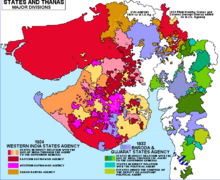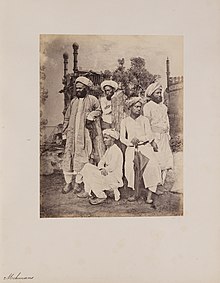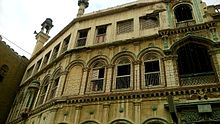| Revision as of 18:15, 3 October 2024 view sourceMmnwla (talk | contribs)82 editsm Copy edit, non encyclopaedic languageTag: Visual edit← Previous edit | Revision as of 00:52, 9 November 2024 view source FatherOfEnigma (talk | contribs)272 edits →History: copyeditTags: Reverted Visual editNext edit → | ||
| Line 28: | Line 28: | ||
| == History == | == History == | ||
| === |
=== Origins === | ||
| ] | ] | ||
| Memon lineage traces back to the ] who traditionally practiced ].<ref name="Pirbhai2009">{{cite book |last1=Pirbhai |first1=M. Reza |title=Reconsidering Islam in a South Asian Context |date=30 September 2009 |publisher=] |location=] and ] |isbn=978-90-474-3102-2 |page=128 |language=en |quote=Thus, it was established that Khojas and Memons converted from Hinduism under the influence of Ismai'li and Sunni ''pirs'', respectively.}}</ref><ref name="Goswami2016">{{cite book |last1=Goswami |first1=Chhaya |title=Globalization before Its Time: The Gujarati Merchants from Kachchh |date=18 February 2016 |publisher=] |isbn=978-93-85890-70-3 |language=en |quote=Most of the Muslim traders were Hindus of different castes who had converted to Islam. The Memons were said to have been Lohanas}}</ref> The origin of the name comes from ] ({{lang|ar|مؤمن}}, "believer" in Arabic) and later evolved to present name Memon.<ref name="Goolam 2006">{{cite journal |last=Vahed |first=Goolam |date=January 2006 |title='Unhappily Torn by Dissensions and Litigations': Durban's 'Memon' Mosque, 1880–1930 |journal=Journal of Religion in Africa |volume=36 |issue=1 |publisher=] |location=] and ] |pages=23–49 |doi=10.1163/157006606775569631 |eissn=1570-0666 |issn=0022-4200 |jstor=27594362}}</ref> The Memon community was founded in the 15th century by 700 families comprising 6,178 persons total.<ref name="Numbers">{{cite journal |title= All for 'Izzat' |first=R |last= Ghadially |url=http://www.manushi-india.org/pdfs_issues/PDF%20files%2066/all_for_izzat.pdf | journal=Manushi |year=1991 |access-date=2017-06-11 |issue=66 |pages=17–20 |pmid=12285436 }}</ref> According to Anthovan, those Lohanas of ], ] who converted from Hinduism to Islam became Memons and were invited by Rao Khengarji Jadeja, ruler of ] in the 16th century, to settle in Bhuj.<ref name="Pirbhai2009"/><ref name="Goswami2016"/> It is from there that ]s migrated to ] and mainland ]. ] in Gujarat was an important trading centre from 1580 to 1680.<ref name="origin3">Islamic Perspective, a Biannual Journal. A special issue on Bohras, Khojas and Memons. Ed. by Asghar Ali Engineer, Bombay, Institute of Islamic Studies. vol.1, Jan 1988, pp. 41-48 </ref> |
Memon lineage traces back to the ] of ], ] who traditionally practiced ].<ref name="Pirbhai2009">{{cite book |last1=Pirbhai |first1=M. Reza |title=Reconsidering Islam in a South Asian Context |date=30 September 2009 |publisher=] |location=] and ] |isbn=978-90-474-3102-2 |page=128 |language=en |quote=Thus, it was established that Khojas and Memons converted from Hinduism under the influence of Ismai'li and Sunni ''pirs'', respectively.}}</ref><ref name="Goswami2016">{{cite book |last1=Goswami |first1=Chhaya |title=Globalization before Its Time: The Gujarati Merchants from Kachchh |date=18 February 2016 |publisher=] |isbn=978-93-85890-70-3 |language=en |quote=Most of the Muslim traders were Hindus of different castes who had converted to Islam. The Memons were said to have been Lohanas}}</ref> The origin of the name comes from ] ({{lang|ar|مؤمن}}, "believer" in Arabic) and later evolved to present name Memon.<ref name="Goolam 2006">{{cite journal |last=Vahed |first=Goolam |date=January 2006 |title='Unhappily Torn by Dissensions and Litigations': Durban's 'Memon' Mosque, 1880–1930 |journal=Journal of Religion in Africa |volume=36 |issue=1 |publisher=] |location=] and ] |pages=23–49 |doi=10.1163/157006606775569631 |eissn=1570-0666 |issn=0022-4200 |jstor=27594362}}</ref> The Memon community was founded in the 15th century by 700 families comprising 6,178 persons total.<ref name="Numbers">{{cite journal |title= All for 'Izzat' |first=R |last= Ghadially |url=http://www.manushi-india.org/pdfs_issues/PDF%20files%2066/all_for_izzat.pdf | journal=Manushi |year=1991 |access-date=2017-06-11 |issue=66 |pages=17–20 |pmid=12285436 }}</ref> According to Anthovan, those Lohanas of ], ] who converted from Hinduism to Islam became Memons and were invited by Rao Khengarji Jadeja, ruler of ] in the 16th century, to settle in Bhuj.<ref name="Pirbhai2009"/><ref name="Goswami2016"/> It is from there that ]s migrated to ] and mainland ]. ] in Gujarat was an important trading centre from 1580 to 1680.<ref name="origin3">Islamic Perspective, a Biannual Journal. A special issue on Bohras, Khojas and Memons. Ed. by Asghar Ali Engineer, Bombay, Institute of Islamic Studies. vol.1, Jan 1988, pp. 41-48 </ref><ref name="Goolam 2001">{{cite journal |last=Vahed |first=Goolam |date=January 2001 |title=Mosques, Mawlanas and Muharram: Indian Islam in Colonial Natal, 1860–1910 |journal=Journal of Religion in Africa |volume=31 |issue=3 |publisher=] |location=] and ] |pages=305–335 |doi=10.1163/157006601X00194 |eissn=1570-0666 |issn=0022-4200}}</ref> | ||
| === Merchant tradesman === | === Merchant tradesman === | ||
Revision as of 00:52, 9 November 2024
Sunni Muslim community in India and PakistanFor other uses, see Memon (disambiguation). Ethnic group
| Total population | |
|---|---|
| 1,800,000 | |
| Regions with significant populations | |
| India | 900,000 (including 200,000 in Mumbai and suburbs) |
| Pakistan | 700,000 |
| Elsewhere | 200,000 |
| Languages | |
| Memoni, Sindhi, Kutchi, Gujarati | |
| Religion | |
| Islam | |
The Memon are a Muslim community in Gujarat India, and Sindh, Pakistan, the majority of whom follow the Hanafi fiqh of Sunni Islam. They are divided into different groups based on their origins: Kathiawari Memons, Kutchi Memons and Bantva Memons from the Kathiawar, Kutch and Bantva regions of Gujarat respectively, and Sindhi Memons from Sindh.
Memons have cultural similarities with the Khoja, Bohra, and other Gujarati peoples. They speak the Memoni language as their first language, which shares vocabulary with the Sindhi language, Kutchi language and Gujarati languages.
Today Memons are connected through globally recognized organisations such as the World Memon Organisation (WMO) and International Memon Organisation (IMO).
History
Origins

Memon lineage traces back to the Lohanas of Thatta, Sindh who traditionally practiced Hinduism. The origin of the name comes from Mu'min (مؤمن, "believer" in Arabic) and later evolved to present name Memon. The Memon community was founded in the 15th century by 700 families comprising 6,178 persons total. According to Anthovan, those Lohanas of Thatta, Sindh who converted from Hinduism to Islam became Memons and were invited by Rao Khengarji Jadeja, ruler of Bhuj in the 16th century, to settle in Bhuj. It is from there that Kutchi Memons migrated to Kathiawar and mainland Gujarat. Surat in Gujarat was an important trading centre from 1580 to 1680.
Merchant tradesman

Due to the mercantile nature of the community, Memons began a significant migration beyond the borders of India in the 18th and 19th centuries. This led to communities developing in the Middle East, South Africa, Sri Lanka and East Asia. Memon traders set up a network of joint stock companies acting in coordination with other members in an area ranging from Central Africa to China. Memon donors made significant financial contributions to construct mosques during this time, including Juma Masjid Mosque and Jamia Mosque. By late 19th century several thousand Memons had settled in Mumbai due to trading. The area of Mumbai in which the Memon traders congregated later became known as the Memonwada.
20th century
The early 20th century saw a consolidation of the Memon community in South Asia as well as South Africa. They began to organise important societies including Memon Education and Welfare Society and Memon Chamber of Commerce. Memon community made significant financial contributions to preserve the Ottoman Empire but were unable to prevent its decline. The partition of India led to significant migration in both directions for the community. The principal mass of Memons was and is composed of petty tradesmen, shopkeepers, grocers, wandering peddlers, and agents and clerks in firms. In regions of Kutch (India), and near Karachi and on the Makran coast of present day Pakistan, the Memons are still engaged in commercial agriculture, gardening, and fishing.
Branches
Subgroups of Memons from Kathiawar
Main article: Memons (Kathiawar)Languages
Main articles: Memon language, Sindhi language, and Kutchi languageSocial structure
Cultural traditions

While Memons are generally Sunni Muslims, many continue to follow Modern Hindu law in matters regarding property inheritance, community leadership structure and mutual support for members. Memon see themselves to be from the Buddhist Kshatriya lineage. Even within Memons, there are caste hierarchies that some follow regarding marriage practices.
According to folklore, the blessings of the Islamic saint Sayad Kadiri upon the Memons are responsible for their success in business and trade. A more pragmatic explanation for their success is that Memon have been historically considered honest brokers. Following commercial caste model, Memons also offer support community members in financial matters by giving loans and offering business assistance. The community annually celebrates 11 April as "Memons Day" through acts of humanitarian service.
Memons worldwide

Today, Memon communities are scattered throughout the world including the United Arab Emirates, Saudi Arabia, Sri Lanka, South Africa, the United Kingdom, the United States and Canada. However, major concentrations of Memon remain located in Karachi, Pakistan and Gujarat, India. In Karachi there is a community of Memon people from Bantva and their descendants known as Bantva Memons. United under the banner of Halari Memon General Jama'at, the Halari Memon are another category and followers of the Hanafi school.
Memons were also one of three classes living in South Africa when Mahatma Gandhi went there in 1893, Memons were traders serving the Indian diaspora in South Africa. Memons are known for their involvement in business and philanthropy, with Memons having played a major part in the building of Pakistani industry.
See also
References
- ^ "Memon association to congregate today - Times of India". The Times of India. 14 February 2014.
- ^ Fazal, Tanweer (18 October 2013). Minority Nationalisms in South Asia. Routledge. ISBN 9781317966463.
- O’Sullivan, Michael (19 September 2023). "No Birds of Passage - A History of Gujarati Muslim Business Communities, 1800–1975". PART I. Harvard University Press: 44. doi:10.4159/9780674294974-003.
- ^ Levin, Sergey (1974). "The Upper Bourgeoisie from the Muslim Commercial Community of Memons in Pakistan, 1947 to 1971". Asian Survey. 14 (3): 231–243. doi:10.2307/2643012. ISSN 0004-4687. JSTOR 2643012.
- "World Memon Organisation | Serving Mankind". wmoworld.com. Retrieved 9 October 2019.
- "IMO - International Memon Organization". www.internationalmemon.org. Retrieved 9 October 2019.
- ^ Pirbhai, M. Reza (30 September 2009). Reconsidering Islam in a South Asian Context. Leiden and Boston: Brill Publishers. p. 128. ISBN 978-90-474-3102-2.
Thus, it was established that Khojas and Memons converted from Hinduism under the influence of Ismai'li and Sunni pirs, respectively.
- ^ Goswami, Chhaya (18 February 2016). Globalization before Its Time: The Gujarati Merchants from Kachchh. Penguin Books. ISBN 978-93-85890-70-3.
Most of the Muslim traders were Hindus of different castes who had converted to Islam. The Memons were said to have been Lohanas
- ^ Vahed, Goolam (January 2006). "'Unhappily Torn by Dissensions and Litigations': Durban's 'Memon' Mosque, 1880–1930". Journal of Religion in Africa. 36 (1). Leiden and Boston: Brill Publishers: 23–49. doi:10.1163/157006606775569631. eISSN 1570-0666. ISSN 0022-4200. JSTOR 27594362.
- Ghadially, R (1991). "All for 'Izzat'" (PDF). Manushi (66): 17–20. PMID 12285436. Retrieved 11 June 2017.
- Islamic Perspective, a Biannual Journal. A special issue on Bohras, Khojas and Memons. Ed. by Asghar Ali Engineer, Bombay, Institute of Islamic Studies. vol.1, Jan 1988, pp. 41-48
- Vahed, Goolam (January 2001). "Mosques, Mawlanas and Muharram: Indian Islam in Colonial Natal, 1860–1910". Journal of Religion in Africa. 31 (3). Leiden and Boston: Brill Publishers: 305–335. doi:10.1163/157006601X00194. eISSN 1570-0666. ISSN 0022-4200.
- Papanek, Hanna (1972). "Pakistan's Big Businessmen: Muslim Separatism, Entrepreneurship, and Partial Modernization". Economic Development and Cultural Change. 21 (1): 11. doi:10.1086/450605. S2CID 86853602.
- Eisenlohr, Patrick (1972). "The Politics of Diaspora and the Morality of Secularism: Muslim Identities and Islamic Authority in Mauritius". Journal of the Royal Anthropological Institute. 12 (2): 400.
- WAI-YIP, Ho (2001). "Historical Analysis of Islamic Community Development in Hong Kong: Struggle for Recognition in the Post-colonial Era". Journal of Muslim Minority Affairs. 21. Taylor & Francis: 65.
- Chopra, Preeti (2007). "Refiguring the Colonial City: Recovering the Role of Local Inhabitants in the Construction of Colonial Bombay, 1854-1918". Buildings & Landscapes. 14: 109–125. doi:10.1353/bdl.2007.0007. S2CID 161702822.
- Moosa, Ismail (2014). "Role of Memon Community during the Caliphate Movement". British Journal of Humanities and Social Sciences. 11 (1).
- Oishi, Takashi (1999). "Muslim Merchant Capital and the Relief Movement for the Ottoman Empire in India, 1876-1924". Minamiajiakenkyu. 11: 71–103.
- Mallampalli, Chandra (2010). "Escaping the Grip of Personal Law in Colonial India: Proving Custom, Negotiating Hindu-ness". Law and History Review. 28 (4). American Society for Legal History: 1060. doi:10.1017/S0738248010000763. S2CID 144494384.
- Wajihuddin, Mohammed (12 April 2017). "Humanitarian work marks Memons' Day". The Times of India. Retrieved 26 May 2020.
- DH (17 April 2007). "Karachi: 300-bed teaching hospital planned". Dawn. Retrieved 4 August 2015.
- "City Nazim praises services of Memon community". Pakistan Press International. Asia Africa Intelligence Wire. 13 October 2003. Retrieved 20 January 2010.
- DH (15 October 2014). "CM wants constitutional path to resolve OGDC issue". Dawn. Retrieved 5 August 2015.
External links
![]() Media related to Memon people at Wikimedia Commons
Media related to Memon people at Wikimedia Commons